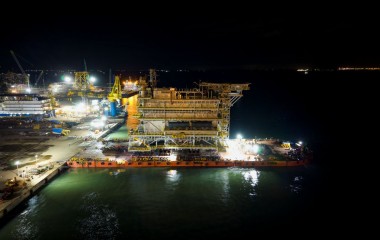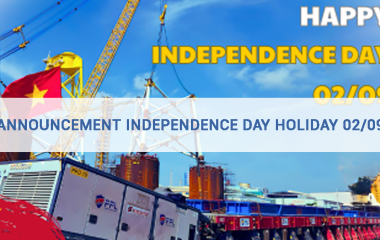[ANSWER] What are the priorities for investors to help develop coastal energy in Vietnam?
What are the priorities for Vietnam to pave the way for more efficient coastal energy development in the coming time? What will be the key levers to unlocking the full potential of coastal renewables?
In this article, PPL and its readers seek answers to the above questions.
Deputy Minister of Industry and Trade - Dang Hoang An attended the Berlin Energy Transition Dialogue 2022 (BETD 2022), a program in a series of activities in Germany recently. Attending BETD 2022 were Mr. Kristoffer Bottzauw - General Director of Danish Energy Agency from Denmark, Ms. Amisha Patel - Head of Public Relations and Corporate Policy Mainstream Renewable Power and Ms. Vera Brenzel - Director of Relations Public and Communications Company Tenne TT.
 Berlin Energy Transition Dialogue 2022
Berlin Energy Transition Dialogue 2022
Coastal energy has great potential
In fact, currently the oceans cover almost 70% of the earth's surface, but coastal energy is still untapped and exploited. For example, the technical potential of offshore wind power is estimated at around 420,000 TWh per year in the world, which is a number that can meet current global electricity consumption. But we have not exploited this full potential yet.
 The oceans cover almost 70% of the earth's surface
The oceans cover almost 70% of the earth's surface
Facing that situation, the speakers at the BETD 2022 dialogue together discussed the issue "How to ensure the widespread deployment of coastal energy technologies?"
According to the Ministry of Industry and Trade, Vietnam is a country with fast economic growth in the ASEAN region, accompanied by rapid urbanization and industrialization and modernization.
This requires the energy and electricity industry to have pioneering development, as a premise and create an environment that meets the conditions needed for the country's sustainable development.
At COP26 in Glasgow last year, Vietnamese Prime Minister Pham Minh Chinh pledged that: “Vietnam will achieve its goal of net zero carbon emissions by 2050.”
And now Vietnam aims to bring in 18 GW of additional wind capacity by 2030.
With these goals in mind, the question asked: “What role will offshore wind play for Vietnam to achieve this goal? How does Vietnam plan to attract investors for offshore wind power projects in the near future? And have any community support programs been applied to offshore wind projects?”
To answer this question, Deputy Minister Dang Hoang An shared: “By declaring the goal of net zero emissions by 2050 at COP26, Vietnam has clearly shown its determination to continue and persistently implement the targets. The goal of converting traditional fossil energy sources to green, clean energy sources, reducing greenhouse gas emissions...
Besides, with favorable geographical and climatic conditions, and a long coastline, Vietnam is considered to have great potential for offshore wind power development. Vietnam's total potential capacity is up to 158 GW, mainly distributed in the South and South Central of Vietnam about 140 GW and the rest about 18 GW in the North and North Central regions.
According to Vietnam, offshore wind power development is of great significance because it can combine the goals of economic and social growth, energy security, industrialization with low carbon emissions towards the goal of achieving sustainable development. Vietnam's net zero emissions by 2050.
According to the latest draft of Vietnam's electricity development plan, it is expected that by 2030, about 16,121 MW of onshore and nearshore wind power will be developed, and about 7,000 MW of offshore wind power by 2030. about 15.8% of the total system capacity, of which offshore wind power is 4.8%.
In the previous stage, Vietnam applied the FIT price mechanism to encourage the development of renewable energy types including offshore wind power. Up to the present time, Vietnam is completing the necessary legal framework to conduct the selection of investors to implement the project in accordance with the provisions of the Investment Law, the Bidding Law and other relevant regulations.
What are the investors' priorities?
The Dialogue also raised the question: “What priorities need to be determined to pave the way for more efficient coastal energy in the coming time? What are the key levers for unlocking the full potential of coastal renewables (such as offshore wind, wave, or tidal power)?”
Deputy Minister Dang Hoang An replied that: In order to effectively exploit this potential offshore wind energy source, Vietnam is trying to perfect the legal basis and prepare favorable conditions for the development of offshore wind energy projects.
The legal basis for this issue includes:
1. Energy source planning associated with marine spatial planning.
2. Completing the legal framework on investment and development of offshore wind power towards a competitive market mechanism.
3. Completing processes and procedures for seabed surveying and sea area assignment.
4. Research and invest in large-scale renewable energy integrated grid infrastructure.
Besides:
5. Vietnam also develops a plan for synchronous development of seaport infrastructure and traffic infrastructure for transportation, equipment installation and construction.
6. Strengthen domestic production, equipment supply and service capacity.
7. Training and improving the quality of human resources in both management and technology.
8. Establish a system of national standards and regulations on technology, equipment, survey, design, transportation,... to ensure management efficiency and conformance with international practices.
Deputy Minister Dang Hoang An also added: Offshore wind power is a new technology, so far Vietnam has only had wind projects on land and near shore, so it is very much in need of support from international partners. economy, especially technology transfer so that in the near future Vietnam can actively build and deploy offshore wind power projects.
 Up to now, Vietnam only has wind projects on land and near shore
Up to now, Vietnam only has wind projects on land and near shore
In recent years, there have been many international organizations and development partners such as the United States, Denmark, the United Kingdom, the World Bank (WB), the Asian Development Bank (ADB), the United States Cooperation Agency The German Development Cooperation (GIZ), the Japan Cooperation Agency (JICA)... have supported Vietnam in conducting potential research studies, sharing experiences and practical lessons on wind power development. in general, as well as offshore wind power in particular.
Vietnam wishes to continue to receive international support in terms of recommendations for policy improvement, technology transfer, and possible solutions to increase the proportion of wind energy in power development plans. national power and energy.
According to the Ministry of Industry and Trade
Related Posts
New Posts
- NOTICE OF NATIONAL DAY HOLIDAY – SEPTEMBER 2ND PROUD TO BE VIETNAMESE
- PPL successfully performs site-move and load-out of record-breaking 4,000-ton offshore substation topside fabricated by PV Shipyard
- HOLIDAY ANNOUNCEMENT: REUNIFICATION DAY & INTERNATIONAL LABOR DAY (April 30 - May 1, 2025)
- ANNOUNCEMENT OF HUNG KINGS’ COMMEMORATION DAY 2025
- PTSC Thanh Hoa and PPL Sign Strategic Partnership
- INDEPENDENCE DAY HOLIDAY ANNOUCEMENT

_cr_380x240.jpg)


_cr_380x240.png)


Comments